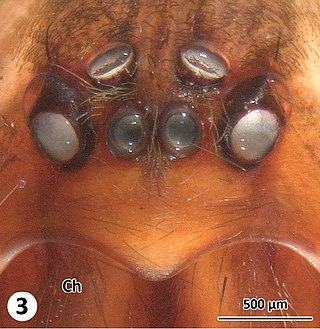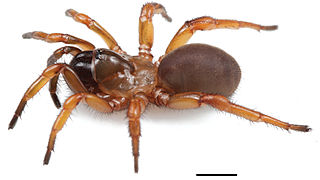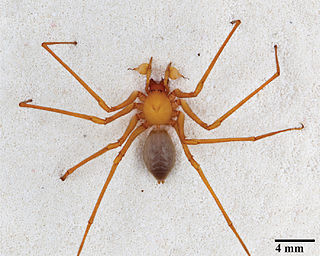
The family Cyrtaucheniidae, known as wafer-lid trapdoor spiders, are a widespread family of Mygalomorphae spiders.

Oonopidae, also known as goblin spiders, is a family of spiders consisting of over 1,600 described species in about 113 genera worldwide, with total species diversity estimated at 2000 to 2500 species. The type genus of the family is OonopsKeyserling, 1835.

Norman Ira Platnick was an American biological systematist and arachnologist. At the time of his death, he was a professor emeritus of the Richard Gilder Graduate School and Peter J. Solomon Family Curator Emeritus of the invertebrate zoology department of the American Museum of Natural History. A 1973 Ph.D. recipient at Harvard University, Platnick described over 1,800 species of spiders from around the world, making him the second most prolific spider taxonomist in history, behind only Eugène Simon. Until 2014 he was also the maintainer of the World Spider Catalog, a website formerly hosted by the AMNH which tracks the arachnology literature, and attempts to maintain a comprehensive list, sorted taxonomically, of every species of spider which has been formally described. In 2007 he received the International Society of Arachnology's Bonnet award, named for Pierre Bonnet, in recognition of his work on the catalog.

Austrochilidae is a small spider family with nine species in two genera. Austrochilus and Thaida are endemic to the Andean forest of central and southern Chile and adjacent Argentina.

Prodidomidae is a family of spider, sometimes called long-spinneret ground spiders. It was formerly regarded as a subfamily of Gnaphosidae, but was raised to a family in 2022.

Unicorn ("one horn", in Latin) is a genus of goblin spiders from South America, containing seven species that occur predominantly in high elevation, semi-desert regions of Bolivia, Chile, and Argentina. Individuals are relatively large for goblin spiders, measuring up to 3.0 mm (0.12 in) in body length. The genus name refers to a characteristic pointed projection between the eyes and jaws of males. In at least one species, broken-off tips of the male pedipalps have been found within the genitalia of females, postulated as a means of sperm competition. Unicorn possesses several traits that suggest it is a relatively "primitive" member of the Oonopidae, and is classified with other similar, soft-bodied goblin spiders in the subfamily Sulsulinae.

Myrmekiaphila is a genus of North American mygalomorph trapdoor spiders in the family Euctenizidae, and was first described by G. F. Atkinson in 1886. All described species are endemic to the southeastern United States.

Jason E. Bond is an American biologist working as a Professor of Entomology and the Schlinger Chair in Insect Systematics at the University of California, Davis.

Aptostichus is a genus of North American mygalomorph spiders in the family Euctenizidae, and was first described by Eugène Simon in 1891. They are found predominantly in southern California, United States.

Trogloraptor is a genus of large spiders found in the caves of southwestern Oregon. It is the sole genus in the family Trogloraptoridae, and includes only one species, Trogloraptor marchingtoni. These spiders are predominantly yellow-brown in color with a maximum leg span of 3 in (7.6 cm). They are remarkable for having hook-like claws on the raptorial last segments of their legs.

Caponiidae is a family of ecribellate haplogyne spiders that are unusual in a number of ways. They differ from other spiders in lacking book lungs and having the posterior median spinnerets anteriorly displaced to form a transverse row with the anterior lateral spinnerets. Most species have only two eyes, which is also unusual among spiders. A few species of Caponiidae variously have four, six or eight eyes. In some species the number of eyes will increase when the spiderling changes its skin as it grows towards adulthood.

The Euctenizidae are a family of mygalomorph spiders. They are now considered to be more closely related to Idiopidae.

Eucteniza is a genus of trapdoor spiders in the family Euctenizidae containing at least 14 species occurring in Mexico and the southern United States. Species are distinguished by a softened rear portion of the carapace, and males possess large spines on the first two pairs of walking legs that are used to hold females during mating. Like other trapdoor spiders they create burrows with a hinged lid, from which they await passing insects and other arthropods to prey upon. Many species are known from only one or two localities, or from only male specimens. More species are expected to be discovered. Eucteniza is closely related to spiders of the genera Entychides and Neoapachella.
Apomastus is a genus of North American mygalomorph spiders in the family Euctenizidae, and was first described by Jason Bond & B. D. Opell in 2002. As of May 2019 it contains only two species, both found in the Los Angeles Basin of southern California: A. kristenae and A. schlingeri.

Laoponia is a genus of Southeast Asian araneomorph spiders in the family Caponiidae, first described by Norman I. Platnick & Peter Jäger in 2008. As of April 2019 it contains only two species.
Anopsolobus is a monotypic genus of Polynesian araneomorph spiders in the family Orsolobidae containing the single species, Anopsolobus subterraneus. It was first described by Raymond Robert Forster & Norman I. Platnick in 1985, and is only known from Nelson in New Zealand.
Namundra is a genus of African long-spinneret ground spiders that was first described by Norman I. Platnick & T. L. Bird in 2007.

Socalchemmis is a genus of North American false wolf spiders that was first described by Norman I. Platnick & D. Ubick in 2001. The genus name comes from a shortening of the phrase "Southern Californian Chemmis", as the genus was discovered in California.

Antrodiaetus pugnax is a species of folding-door spider in the family Antrodiaetidae. It is found in the United States.

















